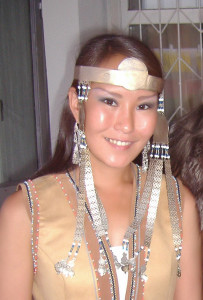© 2016 I.A. Meckyusyarova
 Key words: folk medicine, folk healing, (neo) shaman, sacred practice, Ichchi, algys, herbalist, healer (emchit), chiropractor, fortune-telling, wooing
Key words: folk medicine, folk healing, (neo) shaman, sacred practice, Ichchi, algys, herbalist, healer (emchit), chiropractor, fortune-telling, wooing
Abstract: The author writes about her own childhood experience of getting familiar with traditional knowledge, as well as various ways of treatment in family and folk medicine of the Yakuts (Sakha) in the past and at present. She talks about shamanic practices and shamans’ apprentices, Algyschits and other specialists.
The Sakha people living in Yakutia have always believed that Nature is a living substance, and all objects and phenomena of nature have their spirits – icchi. Spirits are offered sacrifices, mainly through fire. Spells – algys – can be pronounced. Algys translating from Yakut means a ‘blessing’, ‘good will’.
From ancient times, the Sakha people had their own specialists in sacred practices. They were classified in the following way: түүллээх киһи (dreamer), бэриэчиттээх киһи (literal translation: бэриэт – forward; бэриэччиттээх – someone going ahead), аhаҕас эттээх (literally from Yakut “a man with an open, subtle soul”), көрбүөччү (clairvoyant, prophet), эмчит (healer), отоhут (herbalist), ууҥуох тутааччы (bone-healing), ойуун (shaman), удаҕан (shaman), etc.
Shamans were divided into white and black. There were shamans who did ceremonies only for certain diseases. And there were others, stronger and more experienced, who could do ceremonies for various purposes.
The Sakha respected алгысчыттар (those who bless). These specialists conduct diagnostics, find causes of diseases and work specifically to resolve a problem, by conducting алгысы. The ritual is called “Алгыс түһэрии” – a system of actions for establishing a bioenergetic connection of man with the creative power of Nature and coming to awareness of his creative destiny by means of old ritual ceremonial actions. Thus, via алгысы, the expert puts the “lost” person on the true path, inspires hope, directs the thoughts in a good way.
In our time, contemporary specialists often times combine completely different techniques while working with “patients”. So, if алгысчыт has discovered something unusual during diagnostics, and he cannot eliminate it by means of алгысы, he then may conduct a shamanic ritual. Young specialists, who can be tentatively called “neo-shamans”, use not only purely Yakut methods of treatment, but draw from different, mostly Eastern traditional medicines.
References
Alekseev, N.A. (1984) Shamanizm tiurkoiazychnykh narodov Sibiri (opyt areal’nogo sravnitel’nogo issledovaniia) [Shamanism of the Turkic-speaking peoples of Siberia (experience of areal comparative research)], Novosibirsk.
Il’iakhov, P.N. (1994) Iz zhizni Velikogo shaman [From the life of the Great Shaman], Yakutsk.
Fedorov, A.S. (2011) Өbүge siere-tuoma, Iakutsk, D’okuuskai: Bichik
Fedorov, A.S. (2014) Tөlkө tүүlleekhter, bilge bitteekhter [Tekst], Iakutsk, D’okuuskai: Bichik.
Kharitonova, V.I. (1995) Shamanizm i vostochnaia zagovorno-zaklinatel’naia praktika, Kharitonova V.I. Traditsionnaia magiko-meditsinskaia praktika i sovremennoe narodnoe tselitel’stvo [Shamanism and Eastern incantations practice, Kharitonova V.I. Traditional magico-medical practice and contemporary folk healing], M.: IEA RAN.
Kharitonova, V.I. (2006) Feniks iz pepla? Sibirskii shamanizm na rubezhe tysiacheletii [Phoenix from the ashes? Siberian shamanism at the turn of the millennium], Moskva: Nauka.